When Doi Maach is served on a ceramic ikat plov platter, it definitely means the Bong was bitten by a travel bug. My friend Rupam and I are two nomads who met at a vaccination centre. Our love of travel and textiles soon took over and forged our bond and we decided to let it materialise into a holiday and Uzbekistan it was — girl bonding, food, history, architecture and, of course, the Silk Road. The excitement was palpable as most family and friends could not figure out why these two quirky women at this ripe young age needed to embark on such a journey.
Uzbekistan is a landlocked country with borders flirting with Afghanistan, Turkmenistan, Kazakhstan, Kyrgyzstan and Tajikistan. There is no direct flight to Uzbekistan from Kolkata and only one flight via Delhi by Uzbekistan Airlines.

Uzbekistan is a foodie’s delight. Signature dishes include Manti, or beef mince dumplings to die for; a Plov platter; a typical meal of seekh kebab, beer and bread; and Uzbek sweet sugar dollops which can be used in tea and are also served as a welcome gesture
Before delving headlong into the trip, as a history and art buff, I would like to introduce the readers to the history of this Central Asian country that has seen a number of conquerors over the centuries. This has led to the organic creation of its beautiful tapestry of architecture, language, culture and food. It is the essence of a nation of warm, generous and happy people who love India and, of course, Bollywood.
The first settlers in Uzbekistan were nomads from Central Asia who built not only an extensive irrigation system along the Amu Darya and Syr Darya rivers that drain into the Aral Sea, but also the cities of Samarkand, Bukhara and Khiva, which emerged as centres of trade as China began its silk trade with the West.
Soon, the Persian cities started getting involved. Uzbek, which is a state language, owes its origin to an early form of Persian known as Sogdiya at that time. The area was partially conquered by Alexander around 329BC and Persian and Turkish people, too, started settling in the region. It became quite prosperous and, in 1220, the Mongol ruler Genghis Khan invaded and plundered it brutally.
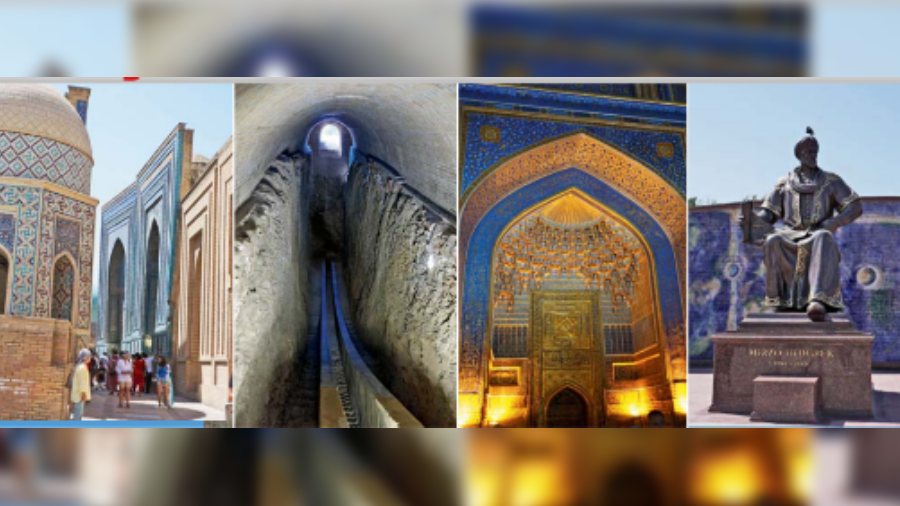
Among the attractions of Samarkand are (left to right) the Gur Emir mausoleum; Ulugbek’s observatory; Tillakori Mosque with its intricate gold ornamentation; and Ulugbek’s statue at the observatory named after him.
Long before the Islamic rule was started by Amir Taimur, the founder of Uzbekistan, the region was ruled for centuries by the (Indian) Kushan dynasty for several centuries and both Hinduism and Buddhism thrived simultaneously and the region flourished in the domains of art, culture and the sciences.
The early Muslim conquerors of the region converted the locals to Islam and prominent among them were scholar Muhammad al-Bukhari and, later, polymath Omar Khayyam.
In the 13th century, after it was invaded by the Mongols, the region was predominantly occupied by the Turkish people and the Mongol conqueror Amir Taimur, the Turko-Mongol conqueror, who is credited to be the father of Uzbekistan. He transferred the capital to Samarkand and started the Temuraid regime. He was a military genius and a very renowned ruler. Central Asia witnessed its Renaissance under his grandson Ulugbek, who took forward his grandfather’s dream and patronised science and technology.
After the 16th century, the Mughal emperor Babur invaded the eastern part of this region and brought it under Mughal rule as a part of his empire, which is how it remained till it became part of the Russian Empire during the 19th century. Russian is one of the languages spoken among the older generation in Uzbekistan and it is home to sections of Russians too.
Note: I strongly recommend you go for the Russian local vodka which will put the Grey Gooses of the world to shame.
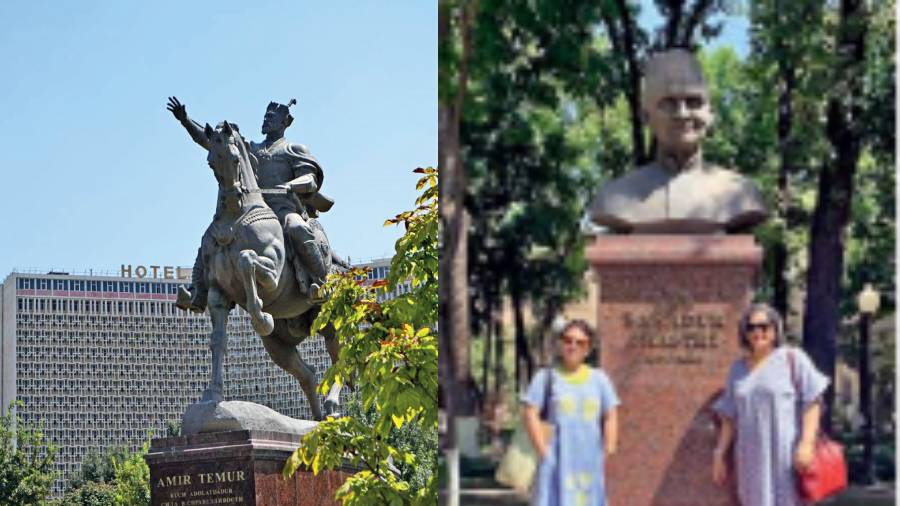
The statue of Amir Temur at the square in Tashkent named after him and with Hotel Uzbekistan in the background; At the Lal Bahadur Shastri Square in Tashkent
Tashkent
Not heeding what is recommended to most tourists by travel agents, we landed in Tashkent and took time to soak in the place. We embarked on a city tour in the afternoon. Before hitting the majestic city centre, the Amir Temur Square, our chirpy guide took us to the Lal Bahadur Shastri Square. It was a sheer delight and pride to see a part of our glorious history in a foreign land.
Tashkent is a modern and extremely well-planned city with broad avenues lined with trees and landscaped parks. In the old section, the Amir Temur Square named after the founder of Uzbekistan, has the grand Hotel Uzbekistan and the Parliament buildings surrounding it reminding us of Lutyens’ Delhi. In 1865, it was captured by Russia and eventually made a part of the USSR.
Besides the national language Uzbek, people also speak Russian. The city’s TV tower and war memorial are priceless pieces of architecture. The metro stations are very interesting with chandeliers and murals. According to the locals, these were loots that the Russians could not carry back when they left and form the main public transportation system of the capital city.
The people are so warm and hospitable that Rupam and I almost reached celeb stature by singing Bollywood numbers everywhere, forget the number of groupfies we clicked. The cafes serve the most awesome beef kebabs and shazhliks and the draught beer was a life-saver as the days were very hot with a blazing sun. Mid-September to April is the ideal tourist season.
On the way back we spent a day here again. We had no idea Tashkent had a beach on the Charvak Lake, an artificial reservoir surrounded by the Chimgan Mountains. We had the most amazing grilled fish there.
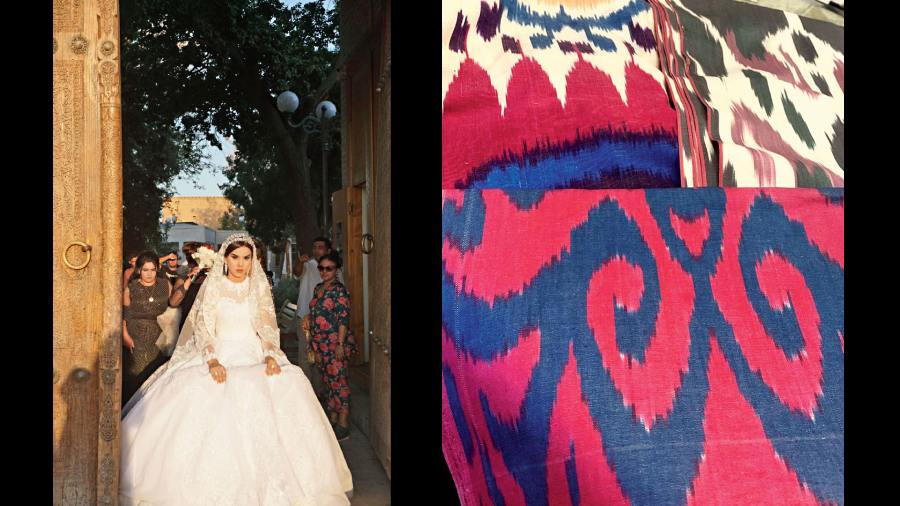
A traditional Uzbek bride in Bukhara; Ikat fabric from Uzbekistan
Samarkand
Founded in the 7th century BC, Samarkand today is on the Unesco World Heritage list as ‘Samarkand — Crossroad of Cultures’. This historical city in the north-east of Uzbekistan was at its most significant during the Timuraid period spanning the 14th and 15th centuries.
The Afrosiab is the centre of Samarkand and was plundered by Genghis Khan in the 13th century. This site has beautiful mosques and minarets. The magnificent architecture with the blue mosaic domes amidst an arid desert terrain is a visual delight. The Islamic architecture has remnants of Mediterranean and Indian influences. One can see a significant similarity between these mausoleums and Fatehpur Sikri in India.
The Gur Emir Mausoleum, a burial vault of the Timuraid dynasty and three madrasas, namely, Ulugbek, Sherdor and Tillakori (gold), are all in the Registan area in the centre of the city square. The grandeur of the sites is proof of the economic opulence the country enjoyed.
One definitely needs to spend two nights in Samarkand. Its other attraction is the silk and ikat fabrics. Geographically, Samarkand was a key point along the Silk Road that formed the trade route between India and China. It was, therefore, a lucrative spot for most Middle-Eastern rulers. Fascinating ikat silks in myriad hues are found around the Siab local bazaar at posh boutiques and smaller shops both in Samarkand and Bukhara.
Besides the architecture and the silks, another interesting aspect is the blue pottery coordinated with the semi-brick and mud architecture. A true-blue Bengali is reminded of Sonar Kella. The ceramic tableware with ikat prints is fascinating for art aficionados like my friend and me. We were like two kids in a candy store. Samarkand is where one can go crazy shopping.
After a hectic touristy day of history and shopping we had to try Plov, a distant cousin of the pulao, which is a signature dish of Uzbekistan. Our guide Anar, who we rechristened Anarkali, explained the recipe of Plov where yellow carrots actually add to the colour and flavour.

Shazhlik served with sourcream
Uzbekistan is dotted with Plov centres and it’s recommended that you choose the ones which serve beer. For vegetarians, there are vegetarian options as well.
The second day was more relaxed; the day being August 15 and having made local friends, we actually sang our national anthem with them. Our hotel, Asia Samarkand, was adjacent to the Registan zone. So, we strolled along to the Bibi Khanim Mosque, which is considered to be the largest medieval building in the area.
After this, we drove to the Ulugbek Observatory, an advanced and important astronomical wonder. We decided to spend a quiet evening at a cafe adjacent to Bibi Khanim with copious cups of Uzbek tea and Manti, the Uzbek version of momos. Gur-e-Amir is another stately piece of architecture which is said to have inspired the Taj Mahal and should not be missed at any cost.
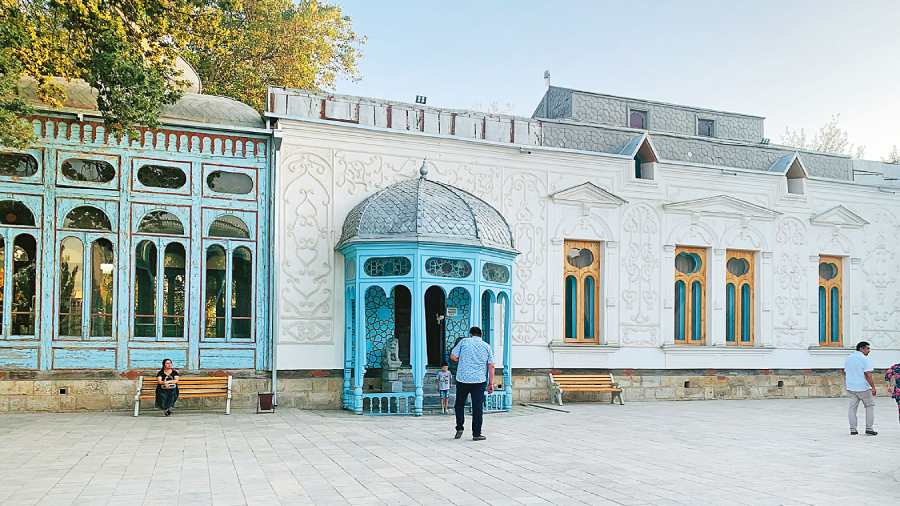
Bukhara is an eight- hour drive from Samarkand and has a similarity with its architecture as seen in the Sitiorai Mokhi Khosa, the summer palace of the last emir of Bukhara
Bukhara
Bukhara is a small sleepy town and served as a pit stop for traders and caravans in the medieval ages. It is a short train ride from Samarkand. The bullet train system of Uzbekistan is immensely impressive. Bukhara is dotted by inns, fortresses and arks. A contrast to the magnificence and opulence of Samarkand, Bukhara gives a glimpse of a medieval Central Asian Muslim city filled with handicraft, bazaars and artefacts.
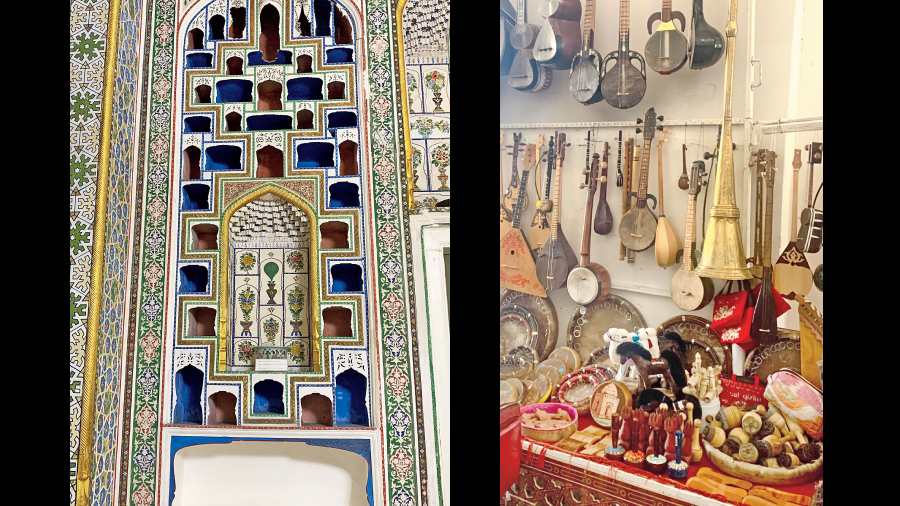
Assorted ware for sale at the market in Bukhara
The 2,000-year-old city is dotted with old taverns and homes which have been transformed into hotels. Ours was in the Lyabi House Complex, a quiet 17th century trading square with a lake and a traditional marketplace with eateries serving piping hot kebabs. Unfortunately, we only had one day in Bukhara where we visited the Ark Fortress, its oldest structure and the residence of its emirs for centuries.
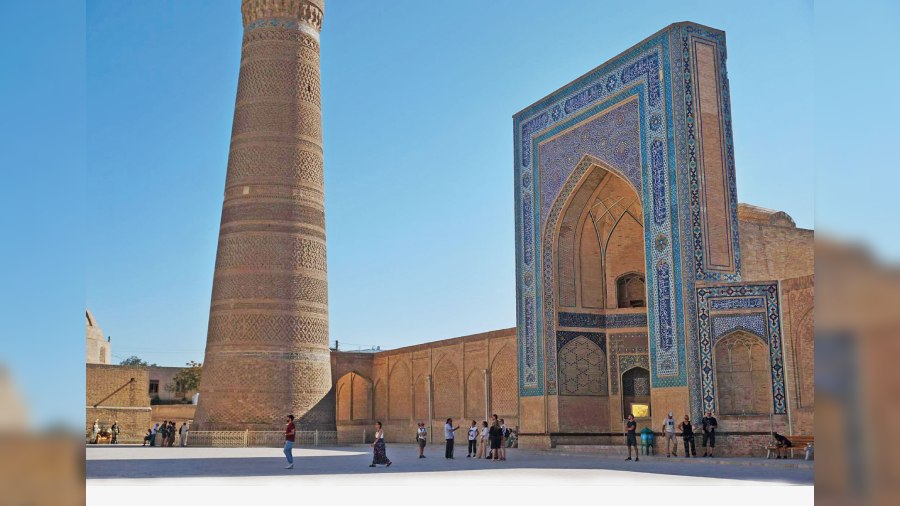
The Bolo-Khauz Mosque
Other monuments worth visiting are the Bolo-Khuz Mosque of the Samani dynasty and the Chashma-Ayub mausoleums.
Several architectural sites under excavation are ruins of sites which were plundered by Genghis Khan and others. Bukhara is still a trading city with huge marketplaces and bustling bazaars selling, among other things, dry fruit, silk and artefacts. The Chor Minar is a remnant of an ancient madrasa built in 1807, boasting of four minarets, each representing a different religion.
The Bolo Hauz Mosque, or the mosque with 40 pillars, is almost in a shambles, its ceiling being held up by 20 wooden pillars.
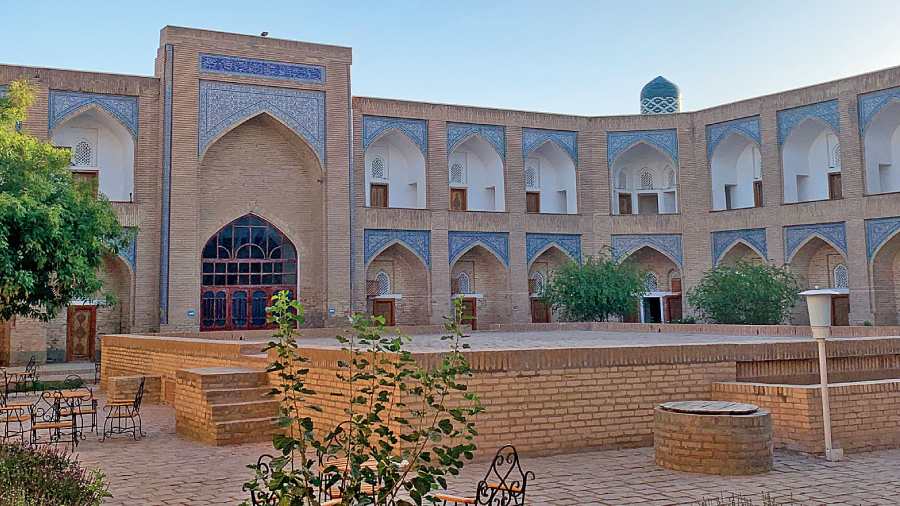
Our hotel that was part of the Lyabi House
My personal favourite was the visit to Sitorai Mokhi Khosa, the summer residence of Bukhara’s last emir, built between 1912 and 1918, a palace with exquisite Mughal and Russian architecture, artefacts and a museum that houses the belongings of the royalty. Legend has it that the emir devoted the palace to his favourite wife Sitorai. Bukhara has a few ancient hamams. Make sure you book a slot in case you are travelling during spring or autumn.
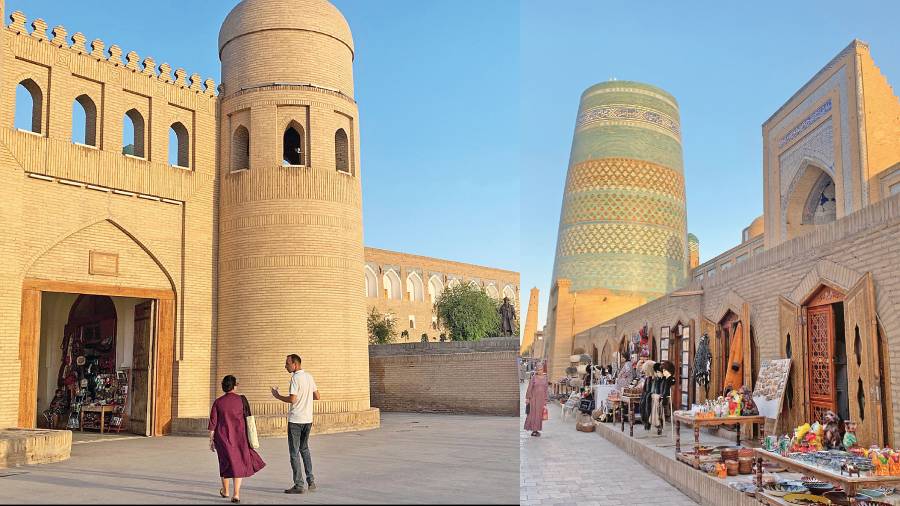
The Ichan Kala fortress and the pavements and streets inside
Khiva
Khiva is the best preserved city out of all the Silk Road landmarks. My personal favourite, it has an aura of magic realism about it. One has to be part of it to believe it. It is an open-air museum dotted with curio shops, cafes, palaces, mosques, clusters of old homes, and sidewalks sprawling with ceramicware. The rustic beauty of the place takes you back into history.
Khiva is an eight-hour drive from Bukhara. So, make sure your driver knows sufficient English as cafes and toilets are few and far between. Archaeologists say Khiva was founded in the 4th or 5th century BC. It is the other old city of the ancient Khorezm empire. It became an important place on the Silk Road. The city was later divided into two parts — Ichan Kala (the inner city) and the Dishan Kala (outer city). These are fortresses with thick high walls to protect the settlements and villages. Ichan Kala is a Unesco World Heritage site. Our hotel, Orient Star, was inside Ichan Kala.
Other interesting sites to visit are the Juma Mosque, Kalta Minor Minaret and Kuhna Ark. The Islam Khoja minaret is worth a visit as one gets a bird’s eye view of the city.
The fascinating part of the entire trip was the linguistic similarities between us and them. There are so many similar words like darwaza, bechara, minar... the list that goes on. The food is to die for and I would never know where ikat had its origin, only the shades are different. One just needs to scratch the surface.
My only regret as a eco buff and environmentalist is that there are hardly any green laws in Uzbekistan. The rivers are drying up and the Aral Sea has shrunk. I cannot help wondering who will preserve such a beautiful country with the water crisis getting worse every day. I’d be embracing life one ace at a time.
Rahmat and dazvidania are two endearing terms we picked up from this country which has survived so many struggles. In Uzbek the former means gratitude and the latter is the Russian for goodbye. Rahmat as the journey of life wells up with such adventures.
Pictures courtesy the author
The author is a PR professional turned social entrepreneur
